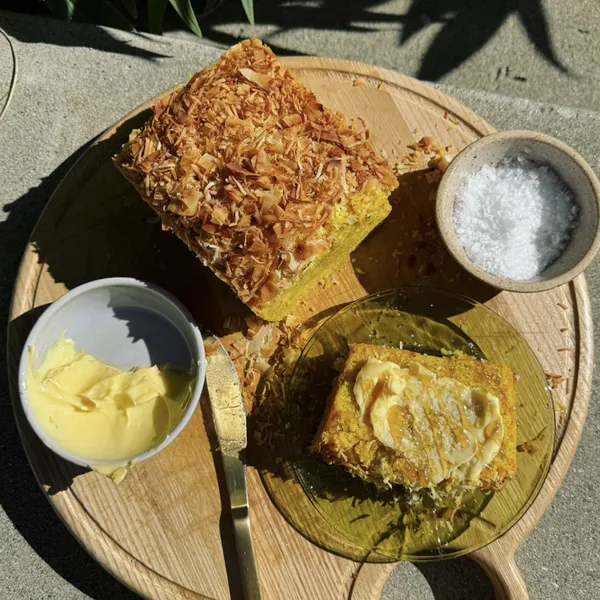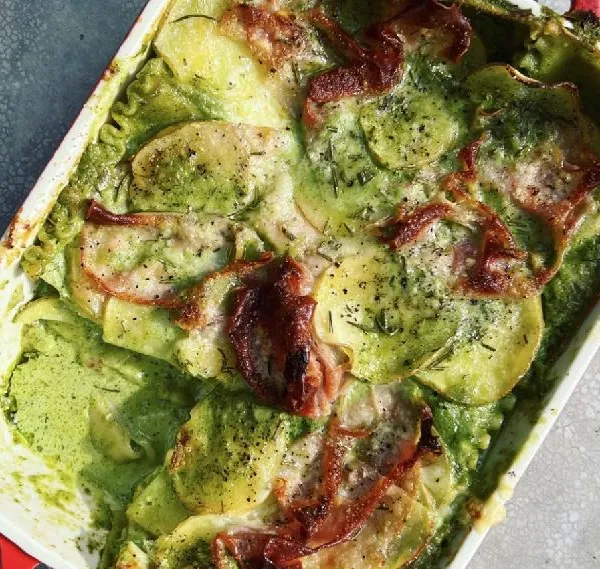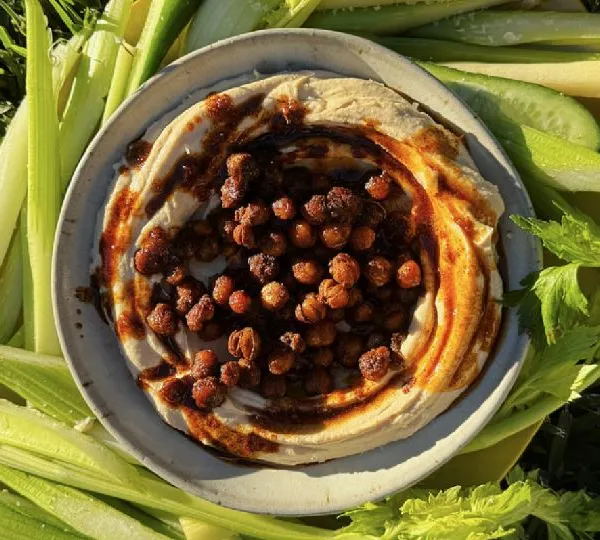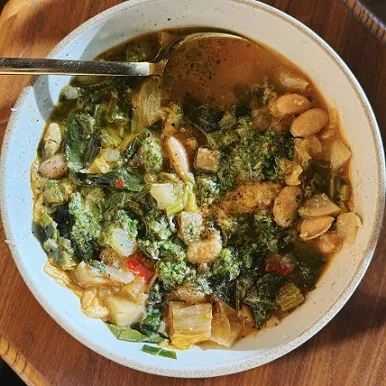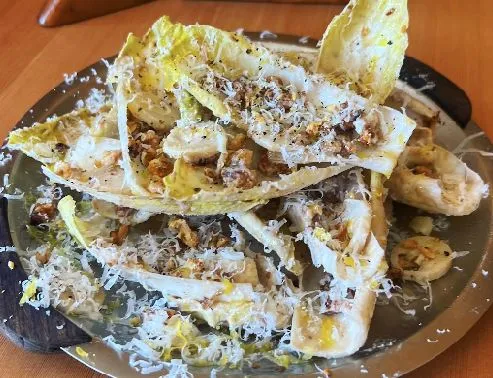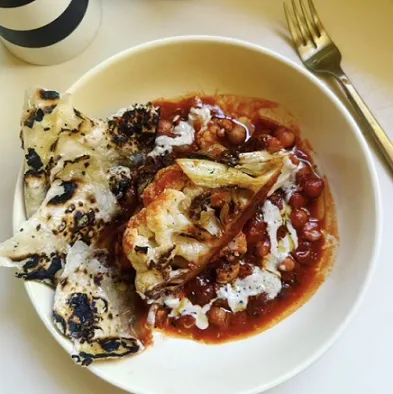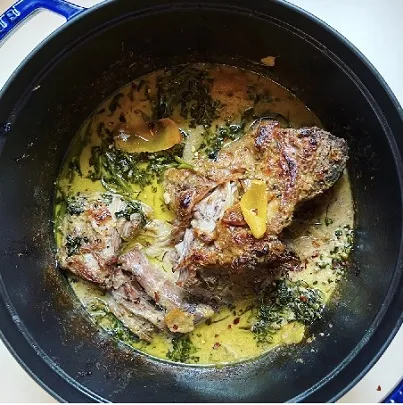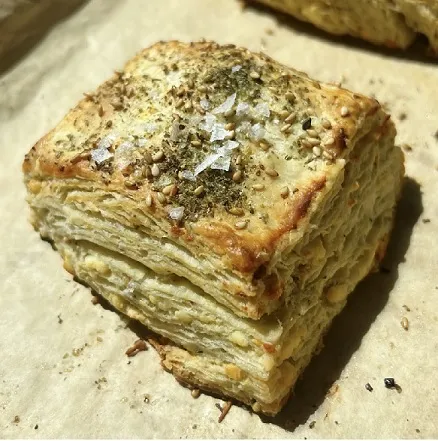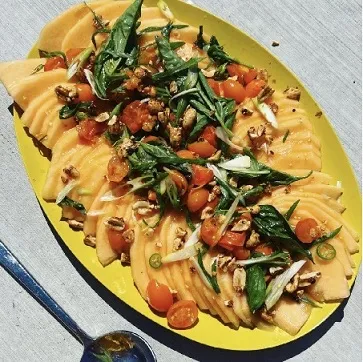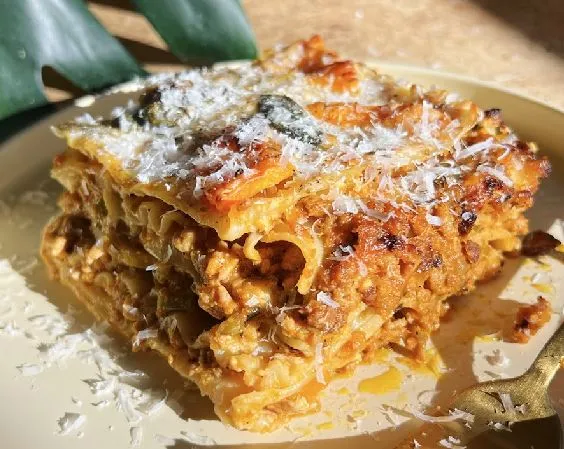
Pork and Pumpkin Lasagna with Miso and Crispy Sage
Serves 1030 mins prep40 mins cook
This lasagna lands somewhere between a classic lasagna bolognese, and a white lasagna with squash and sage. This is fall cooking at its peak.
2 servings
What you need
Instructions
1. Prep the pork and pumpkin ragu: Finely chop 3 celery sticks, 1 yellow onion and 5 ounces of pancetta (if not already diced). Thinly slice 8 garlic cloves. Finely chop a handful of sage leaves (you should have 2 tbsp chopped sage). 2. Start the ragu: Add 1 tablespoon olive oil and the 5 ounces chopped pancetta to a large dutch oven set over medium heat. Cook, stirring occasionally, until the pancetta releases its fat and starts to turn deep brick-colored and crisp, 5-7 minutes. Once browned, scoot the pancetta to the side of the pot with a wooden spoon. Increase to high heat. Add 2 pounds ground pork, in large shaggy balls/ clumps ( (you can just break it apart from the mass as you add it). Season the pork all over with salt and pepper and let cook undisturbed until deeply caramelized underneath, 8-10 minutes. Use a wooden spoon or potato masher to mash the pork up into smaller bits, incorporating the pancetta into them. Once it’s all broken down, add the celery, onions, garlic, and chopped sage. Reduce the heat to medium once again and cook, stirring occasionally until the vegetables soften substantially and pork is fully cooked through, 8-10 minutes longer. Push all of the pork and vegetables to the side of pot to make a little room. Add ¼ cup miso paste and stir into the fat that collects in the pot, breaking the paste up a bit to help distribute. Stir the paste into the pork and vegetables. Next, add 1 ½ cups dry white wine and stir well to deglaze (scraping up the browned bit. Cook for 3-4 minutes, to burn off the raw alcohol flavor. Stir in 1 ½ cups canned pumpkin puree, 1 ¼ teaspoon red pepper flakes, and 1 ½ cups chicken stock or water. Season the ragu well with salt (it will likely need some more). Once the ragu comes to a simmer, cover, reduce to a bare simmer and cook, stirring every 30 or so, for at least 1 hour, and up to 3 hours. The longer it cooks, the more tender the pork will become. But even an hour will do wonders for the depth of flavor. Once it’s done cooking, stir in 2 tablespoons of sherry vinegar. Taste and adjust seasoning and keep covered. 3. Make the bechamel: Heat 5 cups whole milk in a small pot over medium. Try not to boil it! In a second, medium pot, set over medium heat, melt 5 tablespoons of butter. Once melted, add ⅓ cup flour, sprinkling it over the butter. Whisk, until the butter forms a thick paste. (This is a roux!) Cook, over medium, until it turns a light golden color, about 4 minutes. Whisking constantly, stream in the hot milk until it has all been added to the roux. Bring the bechamel to a simmer, and cook, whisking constantly, until thickened, about 8-10 minutes. It’s important to stir frequently here so the bechamel doesn’t burn and stick to the bottom of the pot. Remove from the heat, stir in 2 teaspoons salt, and lots of pepper. Finely grate about ½ of a nutmeg, (or ¾ tsp pre-ground), into the bechamel. Cover and keep off heat. 4. Boil the pasta and assemble: Bring a large pot of water to a boil. Season heavily with salt. Fill a large bowl with ice water for plunging the noodles into once cooked. Once boiling, add 1 pound of lasagna noodles, stirring well so they don’t stick together. Cook for 5-6 minutes, just until malleable, but still VERY al dente. Plunge the noodles into the bowl of ice water for a few minutes to stop the cooking. Drain, and then transfer to a baking sheet to separate the noodles. Drizzle them generously with olive oil and use your hands to coat them all over with the oil so they don't stick together as they cool. Preheat the oven to 375. Lightly butter or grease a 9” x 13” baking dish. Peel and halve your squash (you’ll only need 1 pound total, so if you’re working with a larger squash just approximate) Scoop out and discard the seeds. Thinly slice the squash into ¼” half moons. Layer it up! Spread a thin layer of meat sauce on the bottom of the baking dish. Lay down one layer of lasagna sheets side by side, to cover the bottom of the dish. Top with more ragu (about ¾ cup per layer should be good but you don’t really need to be obsessive about this. Just enough meat sauce to lightly cover each layer.) On top of the meat sauce layer, spoon about ½ cup of bechamel, using the back of a spoon to spread it out if it’s thick. Sprinkle a few big handfulfs of parm (you’ll need up to 6 ounces total for the lasagna depending how deep your dish is, which is a lot, so go heavy on the parm!). Scatter about ⅕ of the squash pieces over the bechamel. Season the squash layer with salt. Top with another layer of lasagna noodles, ragu, bechamel, parm, squash (and salt!). In that order, repeat this process until the lasagna pan is filled up, reserving a handful of squash for the very top layer just in case you use the rest up during layering. If you’re using a standard pyrex glass 9 x 13, you’ll probably have 3-4 layers, a deep dish will require more like 5-6. Both are great! You may have some ragu or bechamel left over. (Toss leftover ragu with pasta the next bday for a quick bowl of pumpkin bolognese!) For the final layer: add a layer of lasagna noodles, cover them in what remains of the bechamel sauce, scatter with remaining squash, sprinkle generously with parm and then scatter another big handful of sage leaves over top. Drizzle the top lightly with olive oil, season with salt and pepper. 5. Bake: Transfer to the oven, uncovered, and cook until the cheese is melted, the sauce is burbling, and the edges of the lasagna have begun to crisp, 40-50 minutes. Turn on the broiler and move the lasagna up to the top rack. Broil until the cheese is brown and spotty, 1 minute longer. Let cool for at least 20 minutes before slicing it–it will stay hot for a very long time.View original recipe

